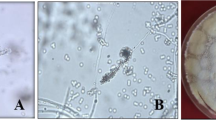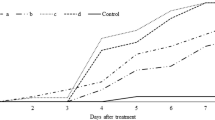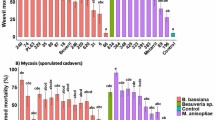Abstract
The two-spotted spider mite Tetranychus urticae is an important pest of strawberry crops in Brazil and many other countries. Focus for biocontrol studies involving entomopathogenic fungi has been on three species from the genus Metarhizium: M. anisopliae sensu stricto (s.s.), M. brunneum and M. robertsii. Also, the species Beauveria bassiana has been studied for spider mite control and one isolate (ESALQPL63) is commercially available in Brazil. New and undescribed Metarhizium species have been found recently in Brazil and provide a pool of isolates with potential for biocontrol in Brazil and probably also elsewhere. The mortality of adult females of T. urticae when exposed to four new Brazilian species of Metarhizium was compared to the mortality when exposed to M. anisopliae s.s., M. brunneum, M. pingshaense, M. robertsii and Beauveria bassiana ESALQPL63. Fungal suspensions were sprayed onto mites at 107 conidia/mL with 0.05% Tween 80 in laboratory bio-assays. We measured total mortality and percentage sporulating cadavers 10 days after exposure and calculated median lethal time (LT50). The lowest LT50 (4.0 ± 0.17) was observed for mites treated with Metarhizium sp. Indet. 1 (ESALQ1638), which also performed well with respect to mortality after 10 days and capacity to sporulate from cadavers. Among the other little studied species tested, M. pingshaense (ESALQ3069 and ESALQ3222) and Metarhizium Indet. 2 (ESALQ1476) performed well and were comparable to B. bassiana (ESALQPL63). The new Metarhizium isolates and species thus showed potential for biological control.


Similar content being viewed by others
References
Attia S, Grissa KL, Lognay G, Bitume E, Hance T, Mailleux AC (2013) A review of the major biological approaches to control the worldwide pest Tetranychus urticae (Acari: Tetranychidae) with special reference to natural pesticides. J Pest Sci 86:361–386
Bischoff JF, Rehner SA, Humber RA (2009) A multilocus phylogeny of the Metarhizium anisopliae lineage. Mycologia 101:512–530
Bugeme DM, Knapp M, Ekesi S, Chabi-Olaye A, Boga HI, Maniania NK (2015) Efficacy of Metarhizium anisopliae in controlling the two-spotted spider mite Tetranychus urticae on common bean in screenhouse and field experiments. Insect Sci 22:121–128
Chandler D, Davidson G, Jacobson RJ (2005) Laboratory and glasshouse evaluation of entomopathogenic fungi against the two spotted spider mite, Tetranychus urticae (Acari: Tetranychidae), on tomato, Lycopersicon esculentum. Biocontrol Sci Technol 15:37–54
de Moraes GJ, Flechtmann CHW (2008) Manual de acarologia. Acarologia básica e ácaros de plantas cultivadas no brasil, vol 1. Ribeirão Preto, Holos
Faria MRD, Wraight SP (2007) Mycoinsecticides and mycoacaricides: a comprehensive list with worldwide coverage and international classification of formulation types. Biol Control 43:237–256
Guzmán-Franco AW, Hernández-López J, Enríquez-Vara JN, Alatorre-Rosas R, Tamayo-Mejía F, Ortega-Arenas LD (2011) Susceptibility of Phyllophaga polyphylla and Anomala cincta larvae to Beauveria bassiana and Metarhizium anisopliae isolates, and the interaction with soil properties. Biocontrol 57:553–563
Iwassaki LA, Sato ME, Calegario FF, Poletti M, Maia Ade H (2015) Comparison of conventional and integrated programs for control of Tetranychus urticae (Acari: Tetranychidae). Exp Appl Acarol 65:205–217
Maniania NK, Bugeme DM, Wekesa VW, Delalibera I Jr, Knapp M (2008) Role of entomopathogenic fungi in the control of Tetranychus evansi and Tetranychus urticae (Acari: Tetranychidae), pests of horticultural crops. Exp Appl Acarol 46:259–274
Marcic D, Prijovic M, Drobnjakovic T, Medjo I, Peric P, Milenkovic S (2012) Greenhouse and field evaluation of two biopesticides against Tetranychus urticae and Panonychus ulmi (Acari: Tetranychidae). Pesticidi i Fitomedicina 27:313–320
Nicastro RL, Sato ME, Da Silva MZ (2010) Milbemectin resistance in Tetranychus urticae (Acari: Tetranychidae): Selection, stability and cross-resistance to abamectin. Exp Appl Acarol 50:231–241
Pena-Pena AJ, Santillan-Galicia MT, Hernandez-Lopez J, Guzman-Franco AW (2015) Metarhizium pingshaense applied as a seed treatment induces fungal infection in larvae of the white grub Anomala cincta. J Invertebr Pathol 130:9–12
Rezende JM, Zanardo ABR, Lopes MD, Delalibera I, Rehner SA (2015) Phylogenetic diversity of Brazilian Metarhizium associated with sugarcane agriculture. Biocontrol 60:495–505
R Development Core Team (2015) R: a language and environment for statistical computing, 3.2.2 ed. Vienna, Austria. Retrived from http://www.R-project.org/. 5 Feb 2016. R Foundation for Statistical Computing
Shi W-B, Zhang L-L, Feng M-G (2008) Field trials of four formulations of Beauveria bassiana and Metarhizium anisoplae for control of cotton spider mites (Acari: Tetranychidae) in the Tarim Basin of China. Biol Control 45:48–55
Stumpf N, Nauen R (2001) Cross-resistance, inheritance, and biochemistry of mitochondrial electron transport inhibitor-acaricide resistance in Tetranychus urticae (Acari: Tetranychidae). J Econ Entomol 94:1577–1583
Vega FE, Meyling NV, Luangsa JJ, Blackwell M (2012) Fungal entomopathogens. In: Vega FE, Kaya HK (eds) Insect Pathology. Academic Press, San Diego, pp 171–220
Wu S, Xie H, Li M, Xu X, Lei Z (2016) Highly virulent Beauveria bassiana strains against the two-spotted spider mite, Tetranychus urticae, show no pathogenicity against five phytoseiid mite species. Exp Appl Acarol 70(4):421–435
Acknowledgements
This research was funded by the Innovation Fund Denmark and The São Paulo Research Foundation (through the Project IMBICONT: ‘Improved biological control for IPM in fruits and berries’, Project Numbers 0603-00486B and 2011/51556-3 respectively). The first author is a recipient of scholarships from the São Paulo Research Foundation (FAPESP, Project Numbers 2013/24430-4 and 2013/10517-0).
Author information
Authors and Affiliations
Corresponding author
Rights and permissions
About this article
Cite this article
Castro, T., Eilenberg, J. & Delalibera, I. Exploring virulence of new and less studied species of Metarhizium spp. from Brazil for two-spotted spider mite control. Exp Appl Acarol 74, 139–146 (2018). https://doi.org/10.1007/s10493-018-0222-6
Received:
Accepted:
Published:
Issue Date:
DOI: https://doi.org/10.1007/s10493-018-0222-6




